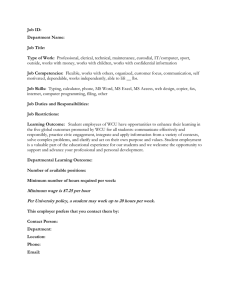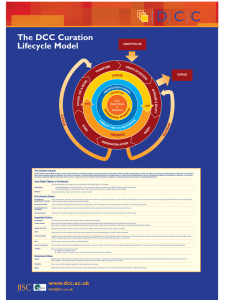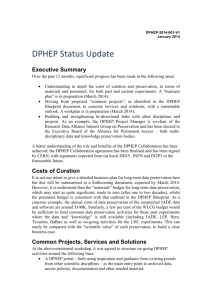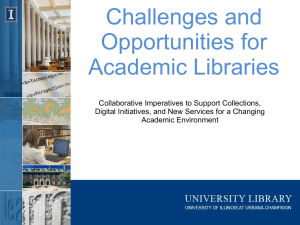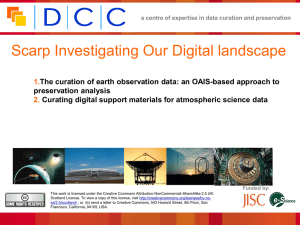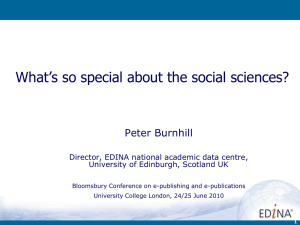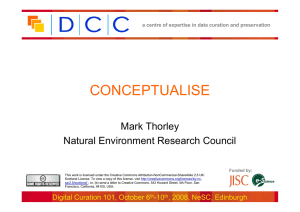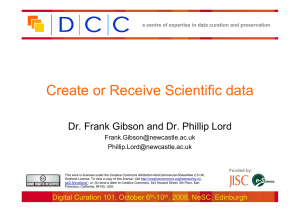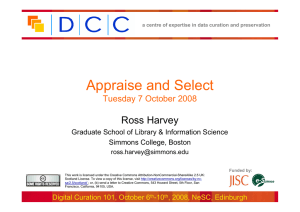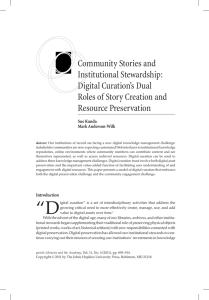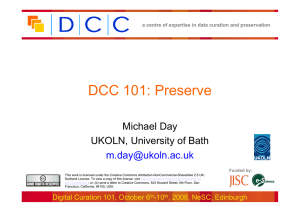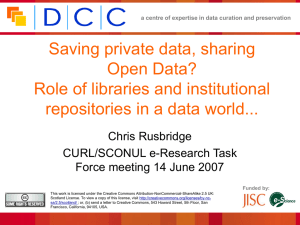Creating Reference Materials for Future Scholars
advertisement
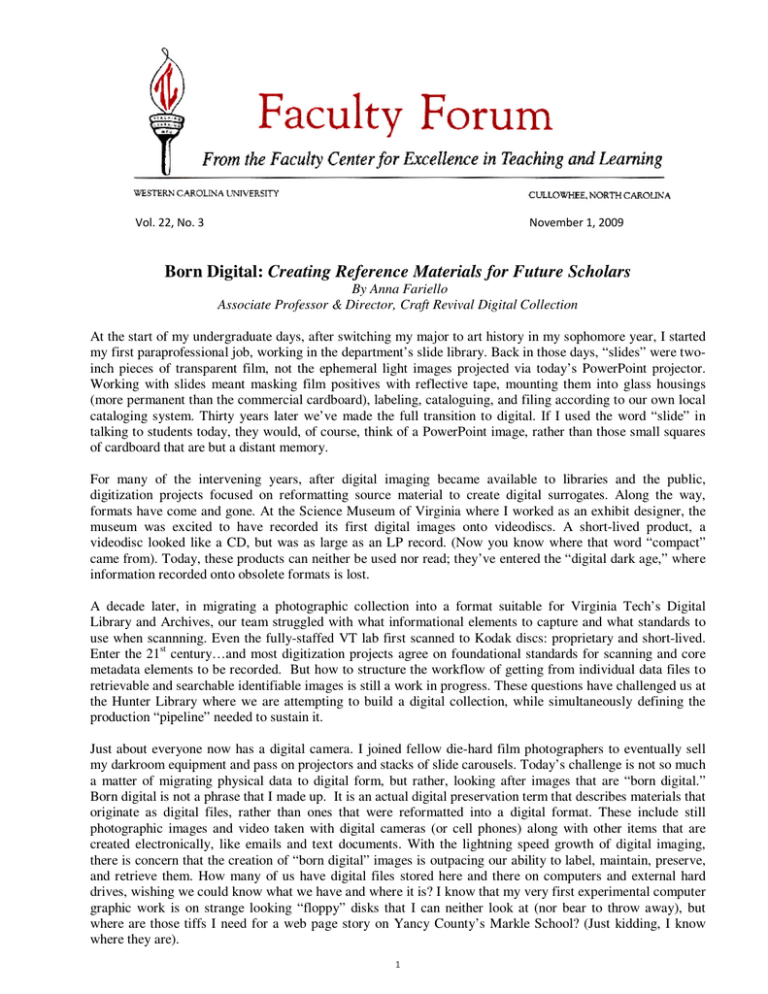
Vol. 22, No. 3 November 1, 2009 Born Digital: Creating Reference Materials for Future Scholars By Anna Fariello Associate Professor & Director, Craft Revival Digital Collection At the start of my undergraduate days, after switching my major to art history in my sophomore year, I started my first paraprofessional job, working in the department’s slide library. Back in those days, “slides” were twoinch pieces of transparent film, not the ephemeral light images projected via today’s PowerPoint projector. Working with slides meant masking film positives with reflective tape, mounting them into glass housings (more permanent than the commercial cardboard), labeling, cataloguing, and filing according to our own local cataloging system. Thirty years later we’ve made the full transition to digital. If I used the word “slide” in talking to students today, they would, of course, think of a PowerPoint image, rather than those small squares of cardboard that are but a distant memory. For many of the intervening years, after digital imaging became available to libraries and the public, digitization projects focused on reformatting source material to create digital surrogates. Along the way, formats have come and gone. At the Science Museum of Virginia where I worked as an exhibit designer, the museum was excited to have recorded its first digital images onto videodiscs. A short-lived product, a videodisc looked like a CD, but was as large as an LP record. (Now you know where that word “compact” came from). Today, these products can neither be used nor read; they’ve entered the “digital dark age,” where information recorded onto obsolete formats is lost. A decade later, in migrating a photographic collection into a format suitable for Virginia Tech’s Digital Library and Archives, our team struggled with what informational elements to capture and what standards to use when scannning. Even the fully-staffed VT lab first scanned to Kodak discs: proprietary and short-lived. Enter the 21st century…and most digitization projects agree on foundational standards for scanning and core metadata elements to be recorded. But how to structure the workflow of getting from individual data files to retrievable and searchable identifiable images is still a work in progress. These questions have challenged us at the Hunter Library where we are attempting to build a digital collection, while simultaneously defining the production “pipeline” needed to sustain it. Just about everyone now has a digital camera. I joined fellow die-hard film photographers to eventually sell my darkroom equipment and pass on projectors and stacks of slide carousels. Today’s challenge is not so much a matter of migrating physical data to digital form, but rather, looking after images that are “born digital.” Born digital is not a phrase that I made up. It is an actual digital preservation term that describes materials that originate as digital files, rather than ones that were reformatted into a digital format. These include still photographic images and video taken with digital cameras (or cell phones) along with other items that are created electronically, like emails and text documents. With the lightning speed growth of digital imaging, there is concern that the creation of “born digital” images is outpacing our ability to label, maintain, preserve, and retrieve them. How many of us have digital files stored here and there on computers and external hard drives, wishing we could know what we have and where it is? I know that my very first experimental computer graphic work is on strange looking “floppy” disks that I can neither look at (nor bear to throw away), but where are those tiffs I need for a web page story on Yancy County’s Markle School? (Just kidding, I know where they are). 1 The purpose of this short article is to make a case for what is known as “curation-at-source.” Quoting from the Digital Curation Centre in Edinburgh, “digital curation is maintaining and adding value to a trusted body of digital information for current and future use.” In museology courses that I’ve taught, I explain that the word “curator” replaced the older term “keeper,” (except in zoos and in England where museum curators are still referred to by this term). However outdated as it may seem, those of us engaged in digital preservation projects are “keepers” of visual and virtual collections. As such, we are responsible for tracking images (registration/cataloging), caring for them (preservation/conservation), and making sense of them (curation/interpretation). The question for all of us is how do we become effective keepers of our own digital stuff? Returning to the basics of writing—who, what, when, and where—is a helpful starting point. Who made/who wrote/who created this image/doc? What is it about? When was it made? Where is it (or where to put it)? Most of us rely on “post hoc digital preservation,” rather than the preferred “curation-at-source” model, but going back often proves to be more difficult than taking the time to draft meaningful tags at the time of creation. When I came to Western in 2005, the task ahead was complex but clear: to identify and create digital images, to provide appropriate documentation and interpretation, to curate a coherent collection, and to make all these into an accessible and understandable resource for students and faculty. In working on the Craft Revival collection, I am constantly aware of the irony of “preserving” the tangible output of 20th century makers in a form that is neither physical nor regional. Our product is immaterial and global. We photograph rivercane baskets to create “born digital” images and load them onto the web for all the world to see. What principles determine the scope of “added value” provided by digital curation? What should we record? Do we want to know who made the basket, or who made the photograph? Do we want to record the measurements of the basket, or the dpi of the photograph? Do we want to know when the basket was made, or the date of the photograph? Of course, the answers to these questions are obvious, we want to know all of this. Those who came to the mountains in the early 20th century to orchestrate the Craft Revival had preservation on their minds, but theirs was not a world of tiffs and jpgs, dpi nor data fields. Theirs was a preservation of skill that meant being able to do something, no matter how small, but being able to do it well. Our goal is to work in that same spirit. The Wiki definition of digital curation is the “process of establishing and developing long term repositories of digital assets for current and future reference by researchers, scientists, and historians, and scholars generally.” That’s exactly what we are attempting to do. Coulter Faculty Center for Teaching and Learning As I prepare this issue of The Faculty Forum for publication, I am finally laughing after several failed attempts to find just where I had stored Anna Fariello’s article about the importance of identifying, storing and being able to actually retrieve important documents and images. Surely she had me in mind when she wrote Born Digital! Vera Holland Guise, Faculty Fellow for Publications We received one piece of feedback to the October issue of The Faculty Forum which featured an article by Dr. Barbara Hardie, Director of the Writing Center. Her article, entitled, A Much-Needed Sea Change, is still open for comment and reflection in next month’s Faculty Forum, so please, after you’ve read Anna Fariello’s article entitled Born Digital, (which most of the faculty here at WCU certainly were NOT) please go back and read Barbara’s article and send us a comment on both. Bruce Henderson Department of Psychology I will read nearly 2,000 pages of student writing this semester. I have never been able to grade papers holistically, so it is a relatively labor intensive process. I have graded papers in a wide variety of contexts, including at ballgames (halftimes and injury timeouts are particularly useful), at concerts, by cool running streams, at weddings (while the pictures are being taken—I am not that gauche), at the mall, at doctor's offices 2 and emergency rooms, on golf courses (many have benches on the tee boxes), and many other places. I don't enjoy giving feedback to students about word usage, transitions, topic sentences, agreement, punctuation, incomplete sentences, affect-effect, who-that, etc. Correcting APA style turns my mind to mush (so I only do it with psych majors). I tell my wife that if meetings don't force me into retirement, grading papers will. Some of my colleagues just tell me not to assign the papers. But if we don't assign the papers and provide the feedback, how are our students going to learn? I am not so naïve as to believe that I am turning my students into writers. Yet, if every instructor required students to write extensively and gave them systematic feedback, surely they would write better. The students would no longer be able to take 21 hours of courses and hold a 30- or 40hour-a-week job, but surely they would be able to write better. I have gotten into a lot of trouble before by saying that our students need to be required to read, write and think more. Oh what the heck, I am a tenured old man. Our students need to be required to read, write and think more. Disclaimer: Please note that the opinions printed here belong solely to the authors and do not necessarily represent the opinions of the editorial staff or of the Faculty Center. If you would like to respond, you may input your comments directly through the wiki on the Faculty Forum webpage, or e-mail vguise@wcu.edu for inclusion in the month following publication of the article to which you wish to respond. You are also encouraged to add your comment electronically by going straight to the Faculty Forum web page at https://media.wcu.edu/groups/facultyforum/wiki. 3

